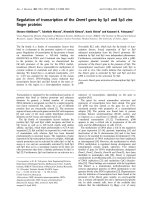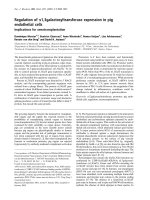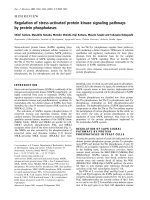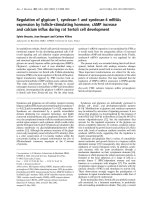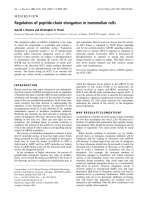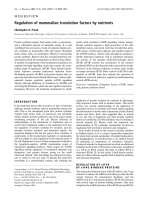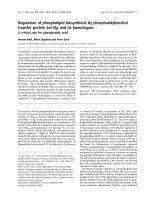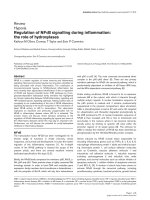Báo cáo Y học: Regulation of RAS in human platelets Evidence that activation of RAS is not sufficient to lead to ERK1-2 phosphorylation pot
Bạn đang xem bản rút gọn của tài liệu. Xem và tải ngay bản đầy đủ của tài liệu tại đây (325.91 KB, 7 trang )
Regulation of RAS in human platelets
Evidence that activation of RAS is not sufficient to lead to ERK1-2 phosphorylation
David Tulasne
1
, Teresa Bori
2
and Steve P. Watson
1
1
Department of Pharmacology, University of Oxford, UK;
2
Division of Medical Sciences, The Medical School,
University of Birmingham, Edgbaston, UK
In this study, w e show that the G protein-coupled receptor
agonist thrombin, the glycoprotein VI agonist convulxin,
and the cytokine receptor Mpl agonist thrombopoietin
(TPO) are able to induce activation of RAS in human
platelets. Recr uitment o f G RB2 by tyrosine-phosphorylated
proteins in response to TPO and convulxin but not by
thrombin occurred with a s imilar time-course to RAS a cti-
vation, consistent with a causal relationship. On the other
hand, activation o f ERK2 b y thrombin a nd convulxin i s
delayed and also inhibited by t he protein kinase C inhibitor
Ro-31 8220, whereas R AS activation is unaffected. Further
evidence for differential regulation of RAS and ERK is
provided by the observations that TPO, which activates
RAS but not p rotein kinase C, does not activate ERK, and
that th e i nhibitor of SRC kinases PP1 inhibits activation of
RAS but not ERK2 in response to thrombin. Our results
demonstrate that activation of RAS is not necessarily cou-
pled to ERK i n human platelets.
Keywords: ERK; glycoprotein VI; platelet; protein kinase C
RAS; signalling; thrombin; t hrombopoietin.
RAS is a ubiquitously expressed G TPase protein, w hich is
activated following conversion from a GDP to GTP-bound
state. GDP –GTP exchange is stimulated by SOS, which is
constitutively associated throu gh its proline rich domain to
the S H3 domains of the adapter GRB2. The Src homology
(SH)2 domain of GRB2 is able to bind phosphorylated
tyrosine residues on tyrosine kinase receptors or membrane-
localized adapters. Loc alization of GRB2–SOS complex to
the plasma membrane, following this recruitment, promotes
RAS activation [1–3].
RAS was discovered as an oncogene, which was in its
activated state by constitutive binding of GTP. A number of
proteins, including RAF, GAP
p120
, MEKK1, and phos-
phatidylinositol-3 kinase (PtdIns3K) are able to interact
with activated RAS ( for review see [4]). The interaction of
RAS with the serine threonine kinase RAF is the most
thoroughly characterized of these interactions. RAF regu-
lates the kinases M EK, which in turn activates ERK1-2
(MAPK p44, p42). ERK1-2 are able to regulate a number
of transcription factors, cytoplasmic proteins and down-
stream kinases.
RAS and all of the components of the RAS–ERK
signalling pathway (RAS, RAF, MEK, ERK) are expressed
in platelets and underg o activation. It has been shown that
the G protein-c oupled receptor agonists thromboxane A
2
and thrombin stimulate GDP–GTP exchange of RAS [5];
the cytokine receptor Mpl agonist thrombopoietin (TPO) is
able to induce activation of RAF [6]; and collagen and
thrombin induce MEK and ERK activation [7]. In the
present study, we show that whereas RAS is activated in
platelets in response to activation by thrombin, glycoprotein
VI (GPVI) agonists and TPO, this is not necessarily coupled
to activation of ERK.
MATERIALS AND METHODS
Antibodies and reagents
Anti-RAS (clone RAS 10, recognizing p21 H-, K- and
N-RAS) and anti-phosphotyrosine 4G10 monoclonal Ig
were purchased f rom Upstate Biotechnology (TCS Biologi-
cals Ltd, UK). Anti-SHC polyclonal and anti-GRB2 mono-
clonal Ig w ere purchased from Transduction Laboratories
(Becton Dickinson Ltd, UK). Anti-GRB2 polyclonal Ig and
anti ERK2 polyclonal Ig were purchased from Santa Cruz
Biotechnology, Inc. Anti-(phospho active ERK phospho-
Thr202/Tyr204) polyclonal Ig was purchased from Promega
Biosciences, Inc. Anti-SYK rabbit polyclonal serum was a
generous gift of M. Tomlinson (DNAX, Palo Alto, C a,
USA). Gluthatione S-transferase (GST)–RAF–RBD fusion
protein was generous gift of Dr F. McKenzie (CNRS UMR
134, Nice, France). Hu man r ecombinant TPO was from
Genentech, Inc. Other reagents were from previously
described sources [8,9].
Platelet preparation
Blood samples were collected from healthy volunteer donors
into 1/10 vol. 3.8% trisodium citrate (w/v) and then 1/10 vol.
of acid/citrate/dextrose ( ACD; 120 m
M
sodium citrate/
110 m
M
glucose/80 m
M
citric acid) was added. Platelet-rich
Correspondence to D. Tulasne, Department of Pharmacology,
University of Oxford, Mansfield Road, Oxford OX1 3QT, UK.
Fax: +44 1865 271853, Tel.: + 44 1865 271590,
E-mail:
Abbreviations:GST,gluthationeS-transferase; GPVI, glycoprotein
VI; PtdIns3K, phosphatidylinositol 3-kinase; PVDF, poly(vinylidene
difluoride); PKC, protein kinase C; PP1, (4-amino-4-(4-methylphe-
nyl)-7-(t-butyl)pyrazola[3,4-d]pyrimidine); SH2, Src homology 2;
SH3, Src homology 3; TPO, thrombopoietin.
(Received 1 9 October 200 1, revised 1 November 2001, accepted
21 January 2 002)
Eur. J. Biochem. 269, 1511–1517 (2002) Ó FEBS 2002
plasma was obtained by centrifugation at 200 g for 20 min.
Platelets were isolated from platelet-rich plasma by ce ntrif-
ugation at 1000 g for 10 min, in the presence of prostacyclin
(0.1 lgÆmL
)1
). The pellet w as resuspended i n 25 mL of a
modified T yrode’s/Hepes buffer ( 134 m
M
NaCl, 0 .34 m
M
Na
2
HPO
4
,2.9m
M
KCl, 12 m
M
NaHCO
3
,20m
M
Hepes,
5m
M
glucose, 1 m
M
MgCl
2
pH 7.3) and 3 mL ACD in the
presence of prostacyclin (0.1 lgÆmL
)1
). Platelets w ere recen-
trifuged at 1000 g for 10 min and resuspended at 5 · 10
8
plateletsÆmL
)1
in Tyrode’s/Hepes buffer. Platelet stimula-
tions were performed at 37 °C in a PAP4 aggregometer with
continuous stirring at 1200 r.p.m. (BioData Corporat ion).
Immunoprecipitation
Platelets (4 · 10
8
cellsÆmL
)1
)treatedfor10minwith
2UÆmL
)1
apyrase, 10 l
M
indomethacin and 1 m
M
EGTA
were lysed with an equal volume of ice-cold Nonidet P-40
buffer [ 20 m
M
Tris, 300 m
M
NaCl, 2 m
M
EDTA, 2 % ( v/v)
NP40, 1 m
M
phenylmethanesulfonyl fluoride, 2 m
M
Na
3
VO
4,
10 lgÆmL
)1
leupeptin, 10 lgÆmL
)1
aprotinin,
1 lgÆmL
)1
pepstatin A, pH 7.3). Lysed cells and debris
were removed by centrifugation. Cell lysates were precleared
for 1 h at 4 °C with protein A–Sepharose. Platelet lysates
were incubated overnight at 4 °Cwith3lL anti-GRB2 or
anti-SHC polyclonal Ig under constant rotation. Protein A–
Sepharose was added and samples were rotated for a further
60 min. The pellet of protein A–sepharose was washed once
in lysis buffer and three times in NaCl/Tris/Tween (10 m
M
Tris, 160 m
M
NaCl, 0.1% Tween 20 (pH 7.3)].
GST precipitation
Platelets (4 · 10
8
cellsÆmL
)1
)treatedfor10minwith
2UÆmL
)1
apyrase, 10 l
M
indomethacin and 1 m
M
EGTA
were lysed with an equal volume of ice-cold Nonidet P-40
buffer containing additional 1% N-octyl glucoside and
5m
M
MgCl
2
. Lysed cells and debris were removed by
centrifugation. Ce ll lysates were precleared for 1 h at 4 °C
with glutathione–agarose. Platelet lysates were incubated
3hat 4°Cwith5lg G ST–RAF–RBD immobilized on
agarose. The pellet was washed once in lysis buffer and three
times in NaCl/Tris/Tween.
Immunoblotting
For ERK ph osphorylation, platelets w ere lysed in 10 · de-
naturating buffer (10% SDS, 100 m
M
NaCl, 50 m
M
Tris,
pH 7.3). Lysed cells and debris were removed by centrifu-
gation. Laemmli buffer was added, and the lysate was boiled
for 2 min. Proteins were separated by SDS/PAGE and
transferred to poly(vinylidene difluoride) (PVDF) mem-
brane. Blots were developed by using the enhanced ch emi-
luminescence detection (ECL) system.
Cytoplasmic and cytoskeleton localization
Platelets were p repared and stimulated as described a bove
and then lysed with an equal volume of ice-cold Triton
X-100 lysis buffer (100 m
M
Tris, 10 m
M
EDTA, 2 m
M
phenylmethylsulphonyl fluoride
,
10 lgÆmL
)1
leupeptin,
pH 7.3). Cell l ysates were centrif ugated at 4 °Cfor2.5h
at 100 000 g. Pellets containing cytoskeleton proteins were
solubilized in SDS sample buffer ( 40% glycerol, 8% SDS,
20% b-mercaptoethanol, 0.008% Bromophenol blue,
250 m
M
Tris/HCl pH 6.8). Proteins from supernatant and
Triton X-100 insoluble-pellet were resolved on S DS/PAGE
and t ransferred to PVDF membrane. Blots were developed
using the ECL system.
Platelet labelling with [
32
P]orthophosphate
Platelets suspended i n Tyrode’s/Hepes without phosphate
were incubated with [
32
P]orthophosphate (0.5 mCi ÆmL
)1
)
for 1 h at 37 °C. Platelets were washed once in Tyrode’s/
Hepes and resuspended at 5 · 10
8
plateletsÆmL
)1
in
Tyrode’s/Hepes plus indomethacin and left 15 min before
the e xperiment as described above. Reactions were stopped
using Laemmli buffer. Proteins were resolved on SDS/
PAGE and visualized by autoradiography.
RESULTS
Platelet aggregation induces RAS localization
to cytoskeleton
Subcellular localization of RAS was determined after
stimulation of platelets by thrombin, convulxin and TPO.
In nonstimulated platelets, RAS was detected in cytoplas-
mic and cytoskeletal fractions, corresponding, respectively,
to detergent soluble and insoluble fractions (Fig. 1 ).
Aggregation i n response t o thrombin induced translocation
of RAS from the cytoplasmic f raction to the cytoskeleton
fraction (Fig. 1A). In the presence of EGTA or RGDS
peptide, both of which inhibit G PIIb-IIIa-dependent aggre-
gation, relocalization of RAS was not observed ( Fig. 1B
and C). A similar set of results was obtained in r esponse to
aggregation induced by the GPVI agonist, c onvulxin (data
not shown). TPO does not induce aggregation o r trans-
location of RAS to the cytoskeletal fraction (Fig. 1D).
Fig. 1. Aggregation in response to thrombin and convulxin induces
relocalization of RAS from the c ytoplasmic to t he cytoskeleton fraction.
(A,B,CandD)Washedhumanplatelets(4· 10
8
ÆmL
)1
)werepre-
treated or n o t for 10 min with 10 m
M
EGTA or 1 m
M
of RGDS
peptide. Platelets were then stimulated with 1 UÆmL
)1
thrombin or
150 n g ÆmL
)1
TPO. Platelets were lysed by the addition of Triton X-100
lysis buffer a t 30, 60, 1 20 or 240 s. Triton X-100 so luble and insoluble
fractions were isolated. Proteins of both fractions were resolved by
12.5% SDS/PAGE and analysed by Western blotting using an
anti-RAS Ig.
1512 D. Tulasne et al. (Eur. J. Biochem. 269) Ó FEBS 2002
Thombin, convulxin and TPO induce activation of RAS
RAS activation was measured through the ability of its
activated form (RAS–GTP) to bind to a GST fusion protein
consisting of the RAS-binding domain of RAF and
subsequent detection by Western blotting. To prevent trans-
location of RAS t o t he insoluble fraction a nd secondary
responses, aggregation mediated by t he integrin GPIIb-IIIa
was inhibited by EGTA and the activation m ediated by
thromboxane A
2
and ADP were blocked by indomethacin
and apyrase, respectively. Thrombin, convulxin and TPO
stimulated a concentration-dependent increase in RAS
activation (Fig. 2A, C and E). Thrombin (1 UÆmL
)1
)
induced maximal RAS activation at 30 s which was
sustained for 240 s. Convulxin (10 lgÆmL
)1
) induced max-
imal RAS activation at 10 s which was also sustained for
240 s. TPO (150 ngÆmL
)1
) stimulated a gradual increase in
RAS activation which was d etectable between 60 and 120 s
and maximal at 2 40 s (Fig. 2B, D and F). These results
indicate th at thrombin, convulxin a nd TPO induce RAS
activation, but with different time-courses.
Convulxin and TPO induce GRB2 recruitment
to phosphorylated adapters
GDP–GTP exchange in RAS is regulated by the exchange
factor SOS, which is constitutively associated with the
adapter GRB2. A constitutive association between GRB2
and SOS was observed in platelets (data not shown).
Tyrosine phosphorylated proteins associated with GRB2
were detected by coimmunoprecipitation and Western
blotting using an anti-phosphotyrosine Ig. As described
previously, in convulxin-stimulated platelets, GRB2 binds
to 36, 50, 70 and 150 kDa phosphorylated-proteins ( [10]
and Fig. 3A). In TPO-stimulated platelets only one
µ
Fig. 2. Thrombin, convulxin and TPO induce RAS activation in a
concentration-dependent manner with different time-course. (A, C and
E) Washed human platelets (4 · 10
8
ÆmL
)1
), prepared in buffer con-
taining EGTA, indometacine and apyrase, were stimulated with
increasing concentrations of thrombin for 120 s, convulxin f or 120 s
and TPO for 240 s. (B, D and F) Washed human platelets were sti-
mulated as indicated time with 1 UÆmL
)1
thrombin, 10 lgÆmL
)1
convulxin or 150 ngÆmL
)1
TPO. Platelets were then lysed b y the
addition of RAS lysis buffer. Cell extracts were preci pitated using GST
fusion protein con taining the RAS-b inding domain o f RAF. Precipi-
tated proteins were resolved by 12.5% SDS/PAGE and analysed by
Western blotting using an anti-RAS Ig (top). Proteins of whole cell
lysate were resolved by 12.5% SDS/PAGE and analysed by Western
blotting using anti-RAS Ig (bottom). Results p resented are represen-
tative of th ree experiments.
Fig. 3. Convulxin and TPO but not thrombin induce the recruitment of
GRB2 on pho sphorylated a dapters. ( A, B and C) W ashed human
platelets were stimulated with 1 UÆmL
)1
of thrombin for 120 s,
10 lgÆmL
)1
convulxin for 120 s and 150 ng ÆmL
)1
of TPO for 240 s.
Platelets were t hen lysed by addition of Nonidet P-40 lysis bu ffer. (A)
Cell extracts were immunoprecipitated using polyclonal GRB2 I g.
Precipitated prot eins were resolved b y 10% SDS/PAGE and analysed
by Western blo tting using an anti-phosphotyrosine Ig (top). The filter
was s tripped and re probed using a monoclonal anti-GRB2 Ig (bot-
tom). (B) Cell extracts were immunoprecipitated using a n anti-SHC I g.
Precipitated prot eins were resolved b y 10% SDS/PAGE and analysed
by Western blotting usin g an a nti-phosphotyrosine I g (top ) or a
monoclonal anti-GRB2 Ig (bottom). (C) Cell ext racts w ere immuno-
precipitated using polyclonal G RB2 I g. Precipitated proteins were
resolved by 10% SDS/P AGE and a nalysed by W estern blotting using
an anti-SYK Ig (top) or anti-L AT Ig (m iddle). The lower part of the
filter was stripped and r eprobed using a mon oclonal anti-GRB2 Ig
(bottom). (D) Human platelets were stimulated from 10 to 240 s with
150 ngÆmL
)1
of TPO and were then lysed. Cell extracts were immuno-
precipitated using an anti-SHC Ig. Precipitated proteins were resolved
by 10% SDS/PAGE and analysed by Western b lotting using an anti-
phosphotyrosine Ig (top) or a monoclonal anti-GRB2 Ig (bottom).
(E) Human platelets were stimulated from 10 to 120 s with 10 lgÆmL
)1
of c onvulxin and were then lysed. Cell extracts were immuno-
precipitated using polyclonal anti-GRB2 Ig. Precipitated proteins were
resolved by 10% SDS/P AGE and a nalysed by W estern blotting using
an anti-phosphotyrosine Ig (top). Th e filter was stripped and reprobed
using a monoclonal anti-GRB2 Ig (bottom). Results presented are
representative of three experiments.
Ó FEBS 2002 Regulation of RAS in platelets (Eur. J. Biochem. 269) 1513
phosphorylated protein was detected at 50 kDa. No change
in the pattern of phosphorylated proteins associated with
GRB2 was observe d in p latelets stimulated by thrombin.
Convulxin and TPO stimulated tyrosine phosphorylation of
the 50 kDa adapter S HC, l eading t o fo rmation o f a
complex with GRB2 (Fig. 3B). In convulxin-stimulated
platelets, GRB2 also coimmunoprecipitated with the a dapter
protein LAT and the tyrosine kinase SYK, suggesting that
these phosph orylated proteins could also recruit GRB2
after stimulation (Fig. 3C). Time-cou rse s tudies indicated
that SHC phosphorylation and GRB2 association in
response t o TP O o ccurred g rad ually with a maximal
response at 240 s (Fig. 3D). In convulxin stimulated-
platelets, association of phosphorylated proteins with
GRB2 was maximal at 10 s and was sustained for at least
240 s (Fig. 3E). The time-course of RAS activation in
response to convulxin and TPO was similar to the
recruitment of GRB2 to phosphorylated adapters.
RAS and ERK are regulated differently
The activation of ERK1 and 2, the downstream k inases of
the RAS–ERK signalling pathway, was measured by
Western blotting using an anti-(phospho-specific ERK1-2)
Ig. Thrombin and convulxin were able to induce phos-
phorylation of ERK kinase after a delay of 60 s (Fig. 4A
and B). Although we have p reviously shown weak phos-
phorylation of ERK1 in r esponse to thrombin and collagen
[7], only ERK2 phosphorylation was detected using the
antiphospho ERK1-2. In contrast, TPO was unable to
induce ERK1 or 2 activation (Fig. 4C).
Treatment of platelets with the protein kinase C (PKC)
inhibitor Ro 31 8220 abolished phosphorylation of the
major PKC substrate pleckstrin and blocked activation of
ERK in response to th rombin and convulxin ( Fig 5 A and
B). This is consistent with previous reports demonstrating
that ERK regulation is mediated downstream of PKC [7]. In
contrast, activation of RAS b y thrombin and convulxin was
not affected by treatment with Ro 31 8220 (Fig. 5C)
suggesting t hat activation o f R AS is not sufficient o n i ts
own to activate ERK in platelets. This is consistent with the
observation that TPO was unable to induce pleckstrin
phosphorylation or a ctivation of ERK despite conversion of
RAS to its GTP-bound form (Fig. 5A a nd C a nd Fig. 4C).
RAS but not ERK activation induced by thrombin
is dependent on SRC kinases
SRC family kinases are necessary for the initial signalling
events induced by GPVI, notably for phosphorylation of
the G PVI-associated rece ptor FcR c-chain [11,12]. A s
expected, the SRC kinase family inhibitor PP1 inhibited
convulxin-induced ERK and RAS activation (Fig. 6A,B).
Interestingly, although activation of ERK in response to
thrombin was not affected by PP1, a ctivation of RAS was
strongly reduced. These results suggest that RAS but not
ERK activation induced by thrombin is regulated by SRC
Fig. 5. PKC inhibitor Ro-31 8220 inhibited ERK but not RAS acti-
vation induced by thrombin, convulxin and TPO. (A, B and C) Washed
platelets o r [
32
P]orthophosphate-labelled p latelets were pretreated for
10minwith10l
M
Ro 31 8220 and stimulated for 2 min with
1UÆmL
)1
thrombin, for 2 min with 10 lgÆmL
)1
convulxin or f or
5 min with 150 ngÆmL
)1
TPO. (A) S timulated l abelled-platelets w ere
lysed in Laemmli sa mple buffer a nd were resolved by 12% SDS/
PAGE. Phosphorylated pleckstrin w as detected by autoradiography.
(B) Platelets were lysed by the addition of denaturating lysis buffer.
Proteins of whole c ell lys ate were r esolved by 1 0% S DS/PAGE a nd
analysed by We stern b lotting using an anti-(phospho-specific ERK1-2)
Ig (top). The filter w as stripped and reprobed using an anti-ERK2 I g
(bottom). (C) Platelets were lysed by the a ddition of RAS lysis buffer.
Cell extracts were precipitated using GST fusion protein containing
the RAS-binding domain of RAF. Precipitated proteins were resolved
by 12.5% SDS/PAGE and analysed by Western blotting using an
anti-RAS Ig (top). Proteins o f whole cell lysate were resolved by
12.5% SDS/PAGE and analysed by Western blotting using anti-RAS
Ig (bottom). Resu lts presented are rep resentative of three experi-
ments.
Fig. 4. Thrombin and convulxin but not TPO induce ERK activation.
(A, B and C) Washed human platelets were stimulated for the times
indicatedwith1UÆmL
)1
thrombin, 10 lgÆmL
)1
convulxin or
150 n g ÆmL
)1
TPO. Platelets were then lysed by addition of denatu-
rating lysis buffer. P roteins of whole cell lys ate were resolved by 10%
SDS/PAGE and a nalysed b y W est ern blo tting u sing a n a nti-(pho spho-
specific ERK1-2) Ig (top). The filter w as stripped and reprobed using
an anti-ERK2 Ig (bottom). Results presented are representative of
three experiments.
1514 D. Tulasne et al. (Eur. J. Biochem. 269) Ó FEBS 2002
family kinases and suggest that activation of R AS is
dispensable for efficient activation of ERK.
DISCUSSION
Activation of RAS was evaluated in platelets through the
ability of t he activated RAS–GTP to b ind a GST f usion
protein containing the RAS-binding domain of RAF.
Different platelet agonists including thrombin, the snake
venom convulxin and TPO were able to activate RAS. It has
been shown that H-RAS is expressed in platelets, but
expression of the isoform ki- and N-RAS was not excluded
[5]. Activated RAS w as detected with an anti-(pan RAS) Ig,
which does not distinguish the various isoforms of RAS. In
platelets, SOS, the exchange factor of RAS, was found in
complex w ith the adapter GRB2. In response to convulxin,
GRB2 associates with a number of phosphorylated pro-
teins. Three of these phosphorylated proteins, t he adapters
LAT and SHC, and the tyrosine kinase SYK were
identified. These proteins belong to the signalling complex
activated by phosphorylation in response to the cross-
linking of GPVI, which is associated with the Fc receptor c
chain. The GPVI-Fc receptor c-chain signalling pathway
shares many features with those of ITAM-containing
receptors in the immune system [13]. Following T-cell
receptor activation, recruitment of GRB2 by LAT and SHC
was s hown to be involved in the activation of the RAS-
ERK signalling pathway [14,15]. The time-course of RAS
activation in response to convulxin was similar to the
recruitment of GRB2 t o phosphorylated adapters, suggest-
ing a possible r egulation of RAS by convulxin through this
mechanism.
In response to TPO, an association between GRB2 and
phosphorylated SHC was identified. This interaction
occurred with a similar time-course to activation o f RAS,
suggesting a causal relationship. In megakaryocytic cell
lines, it has been shown that GRB2 recruitment by
phosphorylated SHC f ollowing c-Mpl r eceptor activation
by TPO contributes to activation of the RAS–ERK
signalling pathway [16].
The S RC kinase family inhibitor PP1 inhibited a ctiva-
tion of RAS in response to thrombin. Activation of RAS
by G coupled-receptors in oth er cell types is also mediated
through the SRC kinases [17–19]. PP1 also inhibited
activation of RAS stimulated by convulxin, consistent with
the r ole o f t hese kinases in m ediation of the phosphory-
lation of the ITAM motif of the Fc receptor c chain
[11,12].
As a principal mechanism, the activation of RAS leads to
the activation of ERK1-2 b y sequential a ctivation of R AS–
RAF–MEK and ERK. In platelets, phosphorylation of
ERK2 in response to thrombin and GPVI agonists is
dependent on PKC ([7] and this study). In contrast, we
found that a PKC inhibitor did not affect RAS activity in
response to thrombin and convulxin. This is consistent with
the observation that TPO, which is unable to induce
activation of PKC, does not stimulate activation of ERK in
platelets. This result indicates that activation of RAS is not
sufficientonitsowntoleadtoERKactivation.The
differential regulation of RAS and ERK was also shown by
the different time-courses of activation between these two
proteins in response to thrombin and convulxin.
In a number of other cells, P KC is also able to regulate
ERK activity. In most of these cases, PKC activates RAF,
whichinturnactivatestheMEK–ERKcascade,but
activation of ERK without involvement of RAF has also
been shown [20,21]. In platelets, t he mechanism of ERK
activation by PKC has not been elucidated. However,
activation of ERK by thrombin, GPVI agonists and
phorbol ester is abolished by inhibitors of MEK ([22] and
data not shown) suggesting that this activation occurs at the
level of, or upstream of, MEK. In addition, it has been
shown that phorbol ester, which induces efficient activation
of ERK, is not able to induce RAF activation in p latelets
[6]. Taken together these results suggest that regulation of
ERK by PKC is not mediated through RAF but more likely
through activation of MEK.
Fig. 6. SRC inhibitor PP1 inhibited RAS but not ERK activation
induced by thrombin. (A a nd B ) H um an pla telet s w ere p retreated for
10 min with 1 0 l
M
PP1 and stim ulated for 2 min with 1 UÆmL
)1
thrombin, for 2 min with 10 lgÆmL
)1
convulxin or for 5 m in with
150 ngÆmL
)1
TPO. (A) Platelets were lysed b y the addition of denat-
urating lysis buffer. Proteins of whole cell lysate were resolved by 10%
SDS/PAGE and analysed by Western blotting using an anti-(phospho-
specific ERK1-2) Ig (top ). The filter was strippe d and reprobed using
an anti-ERK2 Ig (bottom). (B) Platelets were lysed by the a ddition of
RAS lysis buffer. Cell extracts were precipitated using GST fusion
protein c ontaining the RA S-binding domain of RAF. Precipitated
proteins were resolved by 12.5% SDS/PAGE and analysed by Western
blotting using an anti-RAS Ig (top). Proteins of whole cell lysate were
resolved by 12.5% SDS/PA GE and a nalysed by Western blotting
using anti-RAS Ig (bottom). Results presented are repr esentative of
three experiments.
Ó FEBS 2002 Regulation of RAS in platelets (Eur. J. Biochem. 269) 1515
Nevertheless, RAS could participate in the regulation of
ERK b y potentiating the activation mediated by PKC. For
instance, it has been shown that TPO is able to potentiate
ERK activation induced by thrombin [6]. The authors
proposed that this could be due to the a bility of TPO to
activate the e arly events of the R AS signalling pathway.
However, a recent study reported that inhibitors of
PtdIns3K abolished potentiation of ERK by TPO in
response to thr ombin, demonstrating that po tentiat ion is
mediated though the PtdIns3K pathway. The authors
proposed a model in which activation of PtdIns3K by
TPO potentiates activation of MEK induced by thrombin,
whichinturnpotentiatesactivationofERK[23].Whether
this set of events involves activation of RAS is not clear.
TPO i s a lso able to potentiate aggregation a nd secretion
induced by thrombin. Interestingly, although inhibitors of
PtdIns3K abolished this potentiation, the inhibitor of MEK
had no or only a weak effect, suggesting that the MEK–
ERK cascade is not the main downstream event induced by
PtdIns3K to potentiate these functional responses [23].
All of the known components of the RAS–ERK
signalling pathway (RAS, RAF, MEK and ERK) are
expressed in platelets. Furthermore, these proteins can be
activated independently, suggesting that each link is func-
tional [5–7]. In addition, in megakaryocytic cell lines and in
primary megakaryocytes, the precursor of platelets, the
RAS–ERK signalling pathway is activated by T PO and is
essential for differentiation [16,25]. In the last few years, a
number of other proteins able to regulate the RAS–ERK
pathway have been described. This includes scaffolding
proteins, which promote interaction between the links of the
pathway. F or instance, MP1 can bind MEK and ERK1
supporting ERK1 activation [26], and kinase suppressor o f
RAS can bind RAF, MEK and ERK favouring activation
of MEK and ERK1-2 through RAS [27]. On the other
hand, the RAS–ERK signalling pathway can be down-
regulated by proteins able to bind to its components. For
example, the RAF kinase inhibitor protein can bind RAF
and M EK and thereby prevent their interaction [28,29]. A
reduction of the expression of the scaffolding proteins or an
over-expression of proteins responsible for down-regulation
could be an explanation for the inefficiency of RAS to
activate ERK in platelets.
RAS–RAF i nteraction and s ubsequent regulation of ERK
is not the only pathway regulated by RAS. For instance, a
mutated form of RAS that is unable to bind RAF is still
able to induce cytoskeletal rearrangements through activa-
tion of the small G protein RAC [30] and is able to regulate
PtdIns3K [31]. Relocalization of RAS from the cytoplasmic
to the cytoskeleton fraction could suggest an involvement
of RAS during cytoskeleton rearrangement of platelets.
Our study shows that in platelets RAS is not sufficient by
itself to induce activation of its main downstream t arget
ERK. Platelets appear to be a model with which to study
down-regulation of the RAS–ERK signalling p athway and
other functions of RAS. Down-regulation of the RAS–
ERK pathway may be a critical step in the process of end-
stage megakaryocyte differentiation.
ACKNOWLEDGEMENTS
This work was supported by the British Heart Foundation (BHF).
S. P. W. is a BHF Senior Research Fellow .
REFERENCES
1. Buday, L. & Downward, J. (1993) Epidermal growth factor regu-
lates p21ras through the formation of a complex of r eceptor,
Grb2 adapter p rotein, a nd S os nuc leotide e xchange f actor. Cell 73,
611–620.
2. Egan, S.E., Giddings, B .W., Brooks, M .W., Buday, L., Sizeland,
A.M. & W einberg, R.A. (1993) Association of Sos Ras exchange
protein with Grb2 is implicated in tyrosine kinase sign al trans-
duction and transformation. Nature 363, 45–51.
3. Rozakis-Adcock, M., Fernley, R., Wade, J., Pawson, T. &
Bowtell, D. (1993) The SH2 and SH3 domains of mammalian
Grb2 couple th e EGF rec eptor to the Ras activator mSos1. Nature
363, 83–85.
4. McCormick, F. & Wittinghofer, A. (1996) Interactions between
Rasproteinsandtheireffectors.Curr. Opin. Biotechnol. 7,
449–456.
5. Shock,D.D.,He,K.,Wencel-Drake,J.D.&Parise,L.V.(1997)
Ras activation in platelets after stimulation of the thrombin
receptor, thromboxane A2 rece ptor or pr otein kinase C. Biochem.
J. 321, 5 25–530.
6. Ezumi, Y., Uchiyama, T. & Takayama, H. (1998) Thrombo-
poietin potentiates t he protein-kinase-C-mediated a ctivation o f
mitogen-activated protein kinase/ERK kinases and extracellular
signal-regulated kinases in human plate lets. Eur. J. Biochem. 258,
976–985.
7. Borsch-Haubold, A.G., Kramer, R.M. & Watson, S.P. (1995)
Cytosolic phospholipase A2 is phosphorylated in collagen- and
thrombin- stimulated human platelets independent of protein
kinase C and mitogen-activated protein kinase. J. Biol. Chem. 270,
25885–25892.
8. Pasquet, J.M., Quek, L., Stevens, C., Bobe, R., Huber, M.,
Duronio, V., Krystal, G. & Watson, S.P. (2000) Phosphatidy-
linositol 3,4,5-trisphosphate regulates Ca
2+
entry via Btk in
platelets a nd megakaryocytes without increasing pho spholipase C
activity. EMBO J. 19, 2 793–2802.
9. Gibbins,J.,Asselin,J.,Farndale,R.,Barnes,M.,Law,C L.&
Watson, S.P. (1996) Tyrosine phosphorylation of the Fc receptor
c-chain in collagen-stimulated platelets. J. Biol. Chem. 271 , 18095–
18099.
10. Asazuma, N., Wilde, J.I., Be rlanga, O., Le duc, M., L eo, A .,
Schweighoffer, E., Tybulewicz, V., Bon, C., Liu, S.K., McGlade,
C.J., Schraven, B. & Watson, S.P. (2000) Interaction of linker for
activation of T cells with multiple adapter proteins in platelets
activated by the glycoprotein VI-selective ligand, co nvulxin.
J. Biol. Chem. 275, 33427–33434.
11. Briddon, S.J. & Watson, S.P. (1998) Evidence for the involvement
of p59
fyn
and p53/56
lyn
in signalling via the collagen receptor in
human platelets. Bi ochem. J. 33 7 , 203–209.
12. Quek, L.S., Pasq uet, J .M., H ers, I., Cornall, R., Knight, G .,
Barnes, M., Hibbs, M.L. , D unn, A.R., Lowell, C.A. & Watson,
S.P. (2000) Fyn and lyn phosphorylate the Fc receptor gamma
chain downstream of g lycoprotein VI in murine platelets, and lyn
regulates a novel feedback pathway. Blood 96, 4246–4253.
13. Watson, S.P. & Gibbins, J. (1998) Collagen receptor signalling in
platelets: ex tending the role of the ITAM. Immunol. Today 19,
260–265.
14. Ravichandran, K .S., Le e, K .K., Songy ang, Z. , Cantley, L.C.,
Burn, P . & Burakoff, S.J. (1993) Interaction of Shc with the zeta
chain of the T cell receptor upon T cell activation. Science 262,
902–905.
15. Finco, T.S., Kadlecek, T., Zhang, W., Same lson, L.E. & Weiss, A.
(1998) LAT is required for TCR-mediated activation of
PLCgamma1 and the R as pathway. Immunity 9, 617–626.
16. Rojnuckarin, P., Drachman, J.G. & Kaushansky, K. (1999)
Thrombopoietin-induced activation of the m itogen-activated
protein kinase (MAPK) pathway in normal megakaryocytes: role
in endomitosis. Blood 94 , 1273–1282.
1516 D. Tulasne et al. (Eur. J. Biochem. 269) Ó FEBS 2002
17. Sadoshima, J. & Izumo, S. (1996) The heterotrimeric G q protein-
coupled a ngiotensin II receptor activates p21 ras via the tyrosine
kinase-Shc-Grb2-Sos pathway in cardiac myocytes. EMBO J. 15,
775–787.
18. Luttrell, L.M., Hawes, B.E., van Biesen, T., Luttrell, D.K.,
Lansing, T.J . & L efkowitz, R.J. (1996) Role of c-Src tyrosine
kinase in G protein -coupled re ceptor- and Gbetagamma subunit-
mediated activation of m itogen-activated protein kinases. J. Biol.
Chem. 271, 19443–19450.
19. Luttrell, L.M., Della Rocca, G.J., van Biesen, T., Luttrell, D.K. &
Lefkowitz, R.J. (1997) Gbetagamma subunits mediate Src-
dependent phosphorylation of the epidermal growth factor
receptor. A scaffold for G protein-coupled receptor-me diated Ras
activation. J. Biol. Chem. 272, 4637–4644.
20. Grammer, T.C. & Blenis, J. (1997) Evidence for MEK-
independent pathways regulating the prolonged activation of the
ERK-MAP kinases. Oncogene 14, 1635–1642.
21. Bapat, S., Verkleij, A. & Post, J .A. (2001) Peroxynitrite activates
mitogen-activated protein kinase (MAPK) via a MEK-
independent pathway: a role for protein kinase C. FEB S Lett. 499,
21–26.
22. Borsch-Haubold, A.G., K ramer, R.M. & Watson, S.P. (1996)
Inhibition of mito gen-ac tivated protein kinase do es not
impair primary activation of human platelets. Biochem. J. 318,
207–212.
23. Kojima, H., Shinagawa, A., Shimizu, S., Kanada, H., Hibi,
M., Hirano, T. & Nagasawa, T. (2001) Role of phosphatidyli-
nositol-3 kinase and its association with Gab1 in thrombopoietin-
mediated up-regulation of platelet function. Exp. Hematol. 29,
616–622.
24. Bobe, R., Wilde, J.I., M aschbe rger, P., Ven kateswa rlu, K., Cu llen,
P.J., Siess, W. & Watson, S.P. (2001) Phosphatidylinositol
3-kinase-dependent translocation of phospholipase Cgamma2 in
mouse m egakaryocytes is indepe ndent of Bruton tyrosin e kinase
translocation. Blood 97, 678–684.
25. Rouyez, M.C., Boucheron, C., Gisselbrecht, S., Dusanter-Fourt,
I. & Porteu, F. (1997) Control o f thrombopoietin-induced mega-
karyocytic differentiation by the mitogen-activated protein kinase
pathway. Mol. Cell Biol. 17, 4991–5000.
26. Schaeffer, H.J., Catling, A.D., Eblen, S.T., Collier, L.S., Krauss,
A. & Weber, M.J. (1998) MP1: a MEK binding partner t hat
enhances enzymatic activation of the MAP k inase cascade. Science
281, 1668–1671.
27. Therrien, M., Michaud, N.R., Rubin, G.M. & Morrison, D.K .
(1996) KSR m odulates sig nal propag ation w ithin t he MAPK
cascade. Genes Dev. 10, 2684–2695.
28. Yeung, K., Seitz, T., Li, S., Janosch, P., McFerran, B.,
Kaiser, C., Fee, F., Katsanakis, K.D., Rose, D.W., Mischak, H .,
Sedivy, J.M. & Kolch, W. (1999) Suppression of Raf-1 kinase
activity and MAP kinase signalling by RKIP. Nature 401,
173–177.
29. Yeung, K., Janosc h, P., McFerran, B., Rose, D.W., Mischak , H.,
Sedivy, J.M. & K olch, W . ( 2000) M echanism o f supp ression
of the Raf/MEK/extracellular signal-regulated k inase path-
way by the raf kinase inhibitor protein. Mol. Cell Biol. 20,
3079–3085.
30. Joneson, T ., White, M.A., Wigler, M.H. & Bar-Sagi, D. (1996)
Stimulation of membrane r uffling and MAP kinase activation by
distinct effectors of RAS. Sc ience 271, 810–812.
31. Rodriguez-Viciana, P., Warne, P.H., Khwaja, A., Marte, B .M.,
Pappin,D.,Das,P.,Waterfield,M.D.,Ridley,A.&Downward,J.
(1997) Ro le of pho spho inositide 3-OH kin ase in cell transforma-
tion and control of the actin cytoskeleton by Ras. Cell 89,
457–467.
Ó FEBS 2002 Regulation of RAS in platelets (Eur. J. Biochem. 269) 1517
